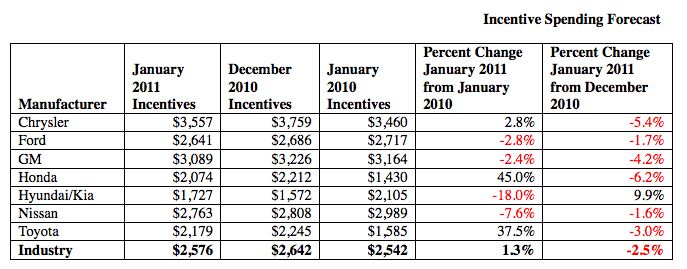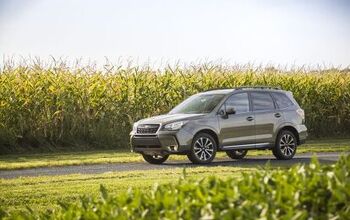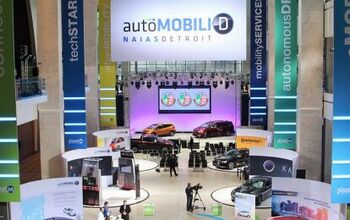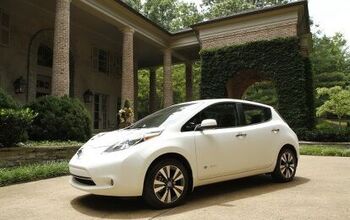January Incentive Report
As any sales-watcher knows, volume isn’t everything. Fleet-retail mixes, incentive spending and transaction prices are all important considerations for putting volume numbers into context. As usual, we’ve assembled Edmunds’ True Cost Of Incentives index as well as TrueCar’s Transaction Pricing and Incentive Spending forecasts, for a complete picture of these important metrics… and after the jump, we’ve added a few notes on the discrepancies between the two firms’ numbers.
There are a few inevitable discrepancies between the Edmunds and TrueCar incentive spends, which we have learned are due to TrueCar’s inclusion of volume-based spiffs and differences in lease-subsidy calculation. Which number is closest to the truth? Well, much of TrueCar’s team used to do forecasting at Edmunds, and though non-disclosure agreements prevent them from explaining in detail how their secret sauce is better, it makes sense that they’d be trying to offer more than their previous employer (and they claim their data is based on more transactions than any other forecasting firm). Meanwhile, Edmunds’ forecasters say they’re “not comfortable” including tough-to-calculate volume-based spiffs. In short, either number could be off a little… but if I had to put money on it, I’d lean towards TrueCar’s numbers.
So, did GM rule incentive spending last month, or did Chrysler? Edmunds calculates that GM spent $3,762 per vehicle, but TrueCar sees The General at a much lower $3,089 average. Edmunds put Chrysler at second place with $3,386 per vehicle, while TrueCar puts ChryCo first with $3,557. Whether this discrepancies are accounted for by lease calculations or volume-based dealer spiffs isn’t at all clear, but TrueCar’s first-place ranking for Chrysler does seem to indicate that one of these factors is pushing up Chrysler’s incentive average. Similarly, the nearly-$500 difference between Honda’s two January 2011 incentive spend forecasts indicates that Honda may be dipping into the volume-based incentives that TrueCar tracks. Either way, it’s clear that incentives are headed down across the board in the short-term (although Honda and Toyota are still up huge in terms of year-over-year gains).
In the short-term, transaction prices seem to be rising slowly from their December levels, although the industry-wide average is still half a percent off its January 2010 mark. In the short-term, only GM appears to be losing ground on transaction pricing (which, taken with incentive levels, give some cause for worry), although over the last year, Honda and Toyota are clearly the biggest losers when it comes to transaction price. Part of that may be tied to falling consumer perceptions, but there’s another, somewhat perverse dynamic at play. TrueCar’s Jesse Toprak explains
Transaction prices dropped slightly in January as consumers purchased a relatively higher percentage of small cars and compact SUVs. If gas prices continue to rise, transaction prices could continue to decline, as consumers tend to shift purchases to smaller, more fuel-efficient vehicles
And because the Detroit automakers gain the greatest transaction-price benefits from strong truck and SUV sales, their transaction price levels could well be the first to suffer from a prolonged rise in fuel prices.
More by Edward Niedermeyer
Latest Car Reviews
Read moreLatest Product Reviews
Read moreRecent Comments
- Brandon I would vote for my 23 Escape ST-Line with the 2.0L turbo and a normal 8 speed transmission instead of CVT. 250 HP, I average 28 MPG and get much higher on trips and get a nice 13" sync4 touchscreen. It leaves these 2 in my dust literally
- JLGOLDEN When this and Hornet were revealed, I expected BOTH to quickly become best-sellers for their brands. They look great, and seem like interesting and fun alternatives in a crowded market. Alas, ambitious pricing is a bridge too far...
- Zerofoo Modifications are funny things. I like the smoked side marker look - however having seen too many cars with butchered wire harnesses, I don't buy cars with ANY modifications. Pro-tip - put the car back to stock before you try and sell it.
- JLGOLDEN I disagree with the author's comment on the current Murano's "annoying CVT". Murano's CVT does not fake shifts like some CVTs attempt, therefore does not cause shift shock or driveline harshness while fumbling between set ratios. Murano's CVT feels genuinely smooth and lets the (great-sounding V6) engine sing and zing along pleasantly.
- JLGOLDEN Our family bought a 2012 Murano AWD new, and enjoyed it for 280K before we sold it last month. CVT began slipping at 230K but it was worth fixing a clean, well-cared for car. As soon as we sold the 2012, I grabbed a new 2024 Murano before the body style and powertrain changes for 2025, and (as rumored) goes to 4-cyl turbo. Sure, the current Murano feels old-school, with interior switchgear and finishes akin to a 2010 Infiniti. That's not a bad thing! Feels solid, V6 sounds awesome, and the whole platform has been around long enough that future parts & service wont be an issue.





































Comments
Join the conversation
If you look at TrueCar's numbers to calculate discount %, you get: -12.3% Chrysler -10.1% Nissan -9.2% Kia -9.1% GM -8.6% Toyota -8.4% Hyundai -8.3% Honda -8.3% Ford GM's not doing badly at all. As the bailout fades in people's memory, and new product comes out, their discount ratio should drop even farther. Chrysler, well, a mediocre car from a mediocre company needs more on the hood to move.
Needless to say, you know who WE at TRUECar.com think has the more accurate numbers. Nice piece, Ed. Let us know if there is anything we can do for you. 86er, trucks continue to lead all categories in sales, so it males sense that the Big 3 continue to focus there. Notice, though, that despite all of the sales, it is green cars and smaller vehicles that garner the innovation....